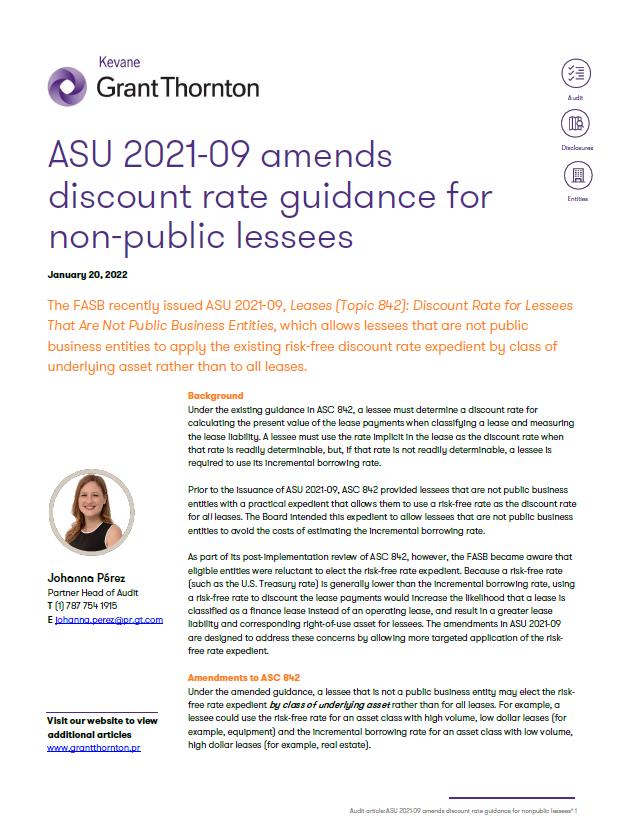-
Financial statements audits
Financial statement audits
-
Compliance audits
Compliance audits
-
Compilations and reviews
Compilations and audit
-
Agreed-upon procedures
Agreed-upon procedures
-
Tax compliance
Business Tax
-
Global mobility services
Through our global organisation of member firms, we support both companies and individuals, providing insightful solutions to minimise the tax burden for both parties.
-
Sales and use tax and indirect taxes
SUT/ VAT & indirect taxes
-
Tax incentives
Navigating the complex landscape of tax incentives in Puerto Rico can be challenging. Whether you're looking to benefit from the Export Services Act (Act 20), the Individual Investors Act (Act 22), or other incentives under Act 60, we provide tailored advice to help you maximize your tax benefits and ensure compliance. Let us help you unlock the potential of doing business in Puerto Rico.
-
Transfer Pricing
The laws surrounding transfer pricing are becoming ever more complex, as tax affairs of multinational companies are facing scrutiny from media, regulators and the public
-
International Business Center
Kevane Grant Thornton is an International Business Center within the Grant Thornton network. Our expert team provides integrated solutions to help Puerto Rico businesses navigate the complex issues that arise when developing global businesses.

-
Business consulting
Our business consulting services can help you improve your operational performance and productivity, adding value throughout your growth life cycle.
-
Business Risk Advisory
Risk is inevitable but manageable. We deliver relevant, timely and practical advices to aid organizations manage risk and improve business performance. We can help you identify, understand and manage potential risks to safeguard your business and comply with regulatory requirements.
-
Technology Advisory
We provide comprehensive solutions to safeguard your business and ensure operational resilience and compliance. Our expert team offers a range of technology advisory services designed to address your cybersecurity needs, enhance business continuity, and manage security effectively.
-
Transactional advisory services
Transactions are significant events in the life of a business – a successful deal that can have a lasting impact on the future shape of the organizations involved. Because the stakes are high for both buyers and sellers, experience, determination and pragmatism are required to bring deals safely through to conclusion.
-
Forensic and investigative services
At Grant Thornton, we have a wealth of knowledge in forensic services and can support you with issues such as dispute resolution, fraud and insurance claims.

Background
Under the existing guidance in ASC 842, a lessee must determine a discount rate for calculating the present value of the lease payments when classifying a lease and measuring the lease liability. A lessee must use the rate implicit in the lease as the discount rate when that rate is readily determinable, but, if that rate is not readily determinable, a lessee is required to use its incremental borrowing rate.
Prior to the issuance of ASU 2021-09, ASC 842 provided lessees that are not public business entities with a practical expedient that allows them to use a risk-free rate as the discount rate for all leases. The Board intended this expedient to allow lessees that are not public business entities to avoid the costs of estimating the incremental borrowing rate.
As part of its post-implementation review of ASC 842, however, the FASB became aware that eligible entities were reluctant to elect the risk-free rate expedient. Because a risk-free rate (such as the U.S. Treasury rate) is generally lower than the incremental borrowing rate, using a risk-free rate to discount the lease payments would increase the likelihood that a lease is classified as a finance lease instead of an operating lease, and result in a greater lease liability and corresponding right-of-use asset for lessees. The amendments in ASU 2021-09 are designed to address these concerns by allowing more targeted application of the risk-free rate expedient.
Amendments to ASC 842
Under the amended guidance, a lessee that is not a public business entity may elect the risk-free rate expedient by class of underlying asset rather than for all leases. For example, a lessee could use the risk-free rate for an asset class with high volume, low dollar leases (for example, equipment) and the incremental borrowing rate for an asset class with low volume, high dollar leases (for example, real estate).
Entities that make this accounting policy election must disclose this election as well as the class (or classes) of underlying assets to which the election has been applied.
The Board also amended ASC 842 to clarify that the risk-free rate is an alternative only to the incremental borrowing rate. In other words, a lessee must use the rate implicit in the lease if that rate is readily determinable, regardless of whether the lessee has elected the risk-free rate expedient.
Effective date and transition
For entities that have not adopted ASC 842 as of November 11, 2021, the amendments in ASU 2021-09 are subject to the same effective date and transition guidance that applies to ASC 842.
Entities that have adopted ASC 842 as of November 11, 2021 are required to apply the amendments for fiscal years beginning after December 15, 2021 and for interim periods within fiscal years beginning after December 15, 2022. Earlier application is permitted as of the beginning of the fiscal year of adoption. Entities are required to apply the amendments on a modified retrospective basis to leases that exist at the beginning of the fiscal year of adoption.
Upon adoption of the amended guidance, an entity that has already adopted ASC 842 may choose to either apply or discontinue the risk-free rate expedient for any class of underlying asset. After remeasuring the lease liabilities for affected leases based on a discount rate and the remaining lease term as of the beginning of the fiscal year of adoption, an entity should adjust the carrying amounts of the affected lease liabilities, with an offsetting adjustment to the corresponding right-of-use assets. If such an adjustment would either cause a right-of-use asset to become a credit balance or increase the carrying amount of a previously impaired right-of-use asset, then the offsetting adjustment should be recognized in opening retained earnings.
Adopting the amended guidance alone does not require a lessee to remeasure and reallocate the consideration in the contract, to reassess the lease term or the likelihood of exercising a purchase option, to remeasure the lease payments under ASC 842-10-35-4, or to reassess lease classification under ASC 842-10-25-1.
A change in the application of the risk-free rate expedient after an entity adopts the amendments would be considered a change in accounting policy that would require further evaluation under ASC 250.
Grant Thornton insight
As with any accounting policy available solely to non-public business entities, entities that are considering becoming public business entities in the future should carefully consider the implications of adopting the risk-free rate expedient. An entity that has applied the risk-free rate expedient to one or more asset classes would be required to “undo” the expedient when preparing financial statements as a public business entity.
This process could be challenging, as it would involve retroactively estimating the incremental borrowing rate at the later of the lease commencement date or the date at which the lease required remeasurement using an updated discount rate.
Source: Grant Thornton Insight December 3, 2021
We are committed to keeping you up to date of all developments that may affect the way you do business in Puerto Rico. Please contact us for further assistance in relation to this or any other matter.




